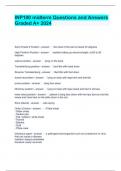INP100 midterm Questions and Answers Graded A+ 2024
Semi-Fowler's Position - answer the head of the bed is raised 30 degrees
High Fowler's Position - answer resident sitting up almost straight, at 60 to 90 degrees
supine position - answer lying on the back
Trendelenburg position - answer bed tilts with head down
Reverse Trendelenburg - answer Bed tilts with foot down
dorsal recumbent - answer lying on back with legs bent and feet flat
prone position - answer lying face down
lithotomy position - answer lying on back with legs raised and feet in stirrups
knee-chest position - answer patient is lying face down with the hips bent so that the knees and chest rest on the table (bum in the air)
Sims (lateral) - answer side laying
Order of linens - answer - Fitted sheet
- Slider sheet
- Soaker pad
- Flat / bottom / white sheet
- Flannel
- Blanket - Quilt
- Pillow case
Infectious agent - answer a pathogen/microorganism such as a bacterium or virus that can cause a disease resident: deeply embedded transient: easily removed Potential for microorganism to be pathogenic - answer - Sufficient amount
- Virulence (strength)
- Pathogenicity (capability)
- Ability to enter and survive in host
- Host susceptibility
Infection - answer invasion of the body by a pathogenic organism; colonized in prolific amounts
can be transmitted to others (are communicable)
exogenous infection - answer external microorganisms that do not belong to the individuals normal flora (person to person)
endogenous infection - answer clients flora is altered from another part of body ex. pinkeye bum to mouth
Reservoir - answer A place where the pathogen grows and reproduces ex. Human body, animals, plants, soil, inanimate objects, water, food
portal of exit - answer path by which agent leaves reservoir
ex: mouth, nose, eyes, rectum, wounds
carried though blood and bodily fluids
excretions - answer feces, urine, vomit
secretions - answer saliva, mucous, semen, sputum
mode of transmission - answer Specific ways in which microorganisms travel from the reservoir to the suseptible host
contact transmission - answer the spread of an agent of disease by direct contact, indirect contact, or droplet transmission
direct contact transmission - answer person to person/ skin to skin transmission
ex. c.diff, staph, MRSA, heroes simplex, VRE, CPO
indirect contact transmission - answer spreads to a host by a nonliving object called a fomite
ex. c.diff, staph, RSV, MRSA, VRE, CPO
droplet transmission - answer transmission via airborne droplets from the respiratory system of an infected source less than 1 meter airborne transmission - answer smaller airborne particles can remain suspended in the air for long periods of time, can be transmitted over a meter away
Airborne precautions - answer -isolation, neg pressure room
-staff wear n95 prior to entering
-door closed at all times
Droplet precautions - answer - mask
- eye protection within 3 meters - clean hands
Routine Precautions - answer - on everybody - hand washing - wearing PPE for contact with blood and bodily fluids
Transmission based precautions - answer - For suspected or positive infection -PPE based on precautions
vectorborne transmission - answer transmission of microbes to humans by insects / pests
ex. fleas, mosquitos, ticks, rats
vehicle transmission - answer single contaminated source transfers infection to multiple susceptible host
through blood, water, food, drugs, equipment
an outbreak
epidemic - answer A widespread outbreak of an infectious disease, smaller scale than pandemic
Pandemic - answer Disease that occurs over a wide geographic area and affects a very high proportion of the population, larger scale than epidemic
endemic - answer confined to a particular country or area
susceptible host - answer a person likely to get an infection or disease, usually because body defenses are weak
depends on virulence of pathogen may need reverse isolation ex. malnourished patient, infants or elderly, under stress, pts who live are admitted to facility
inflammation - answer a localized response to an injury or to the destruction of tissues
body's normal defense body's way if repairing cells and tissues




